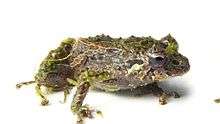Pristimantis mutabilis
| Pristimantis mutabilis | |
|---|---|
 | |
| Not evaluated (IUCN 3.1) | |
| Scientific classification | |
| Kingdom: | Animalia |
| Phylum: | Chordata |
| Class: | Amphibia |
| Order: | Anura |
| Family: | Craugastoridae |
| Genus: | Pristimantis |
| Species: | P. mutabilis |
| Binomial name | |
| Pristimantis mutabilis Guayasamin, Krynak, Krynak, Culebras, and Hutter, 2015[1] | |
Pristimantis mutabilis, also known as mutable rainfrog, is a species of frog found in the Ecuadoran Andes in the Pichincha and Imbabura Provinces.[2] Pristimantis mutabilis is the first known amphibian species that is able to change skin texture from tuberculate to almost smooth in a few minutes, an extreme example of phenotypic plasticity.[1] The specific epithet mutabilis (changeable) refers to this ability. The physiological mechanism behind the skin texture change remains unknown.[1]
Taxonomy and discovery
Pristimantis mutabilis was formally described in 2015 in the Zoological Journal of the Linnean Society; the holotype was collected in 2013. The species was placed in the genus Pristimantis on the basis of genetic studies supported by the morphological analysis.[1] The new species was first spotted in 2006, but only in 2009 the first specimen was collected and its unusual abilities were discovered.[3]
Also Pristimantis sobetes, a related species but from a different species group, have been found to display similar skin texture plasticity, suggesting that this trait may be more common in Pristimantis than in other amphibians.[1]
Description
Males measure about 17 mm (0.67 in) and females 21–23 mm (0.83–0.91 in) in snout–vent length. In life, males have light brown to pale greyish green dorsum, with bright green marks and grey to dark brown chevrons, outlined by thin cream or white line, with orange dorsolateral folds. The belly is pale grey to brown with darker, diffuse spots, and few small white spots.[1] Females have red flash coloration.[1]
Habitat and conservation
The species' habitat is arboreal and it is known from both primary and secondary Andean forests.[1]
Pristimantis mutabilis is only known from three sites in two separate reserves. Based on the vocalizations during the night, it is abundant, but it is difficult to see because of its arboreal habits. Guayasamin and his colleagues suggest that the species should be classified as "Data Deficient".[1]
References
- 1 2 3 4 5 6 7 8 9 Guayasamin, Juan; Krynak, Tim; Krynak, Katherine; Culebras, Jaime; Hutter, Carl (2015). "Phenotypic plasticity raises questions for taxonomically important traits: a remarkable new Andean rainfrog (Pristimantis) with the ability to change skin texture". Zoological Journal of the Linnean Society. 173 (4): 913–928. doi:10.1111/zoj.12222.
- ↑ Frost, Darrel R. (2015). "Pristimantis mutabilis Guayasamin, Krynak, Krynak, Culebras, and Hutter, 2015". Amphibian Species of the World: an Online Reference. Version 6.0. American Museum of Natural History. Retrieved 27 March 2015.
- ↑ Becky Oskin (24 March 2015). "Shape-Shifting Frog Can Change Its Skin Texture". Live Science. Retrieved 27 March 2015.